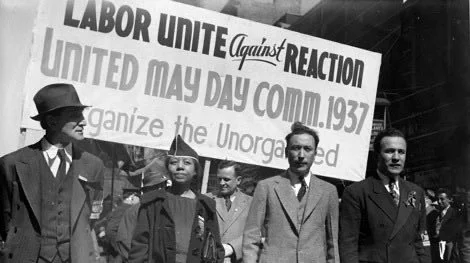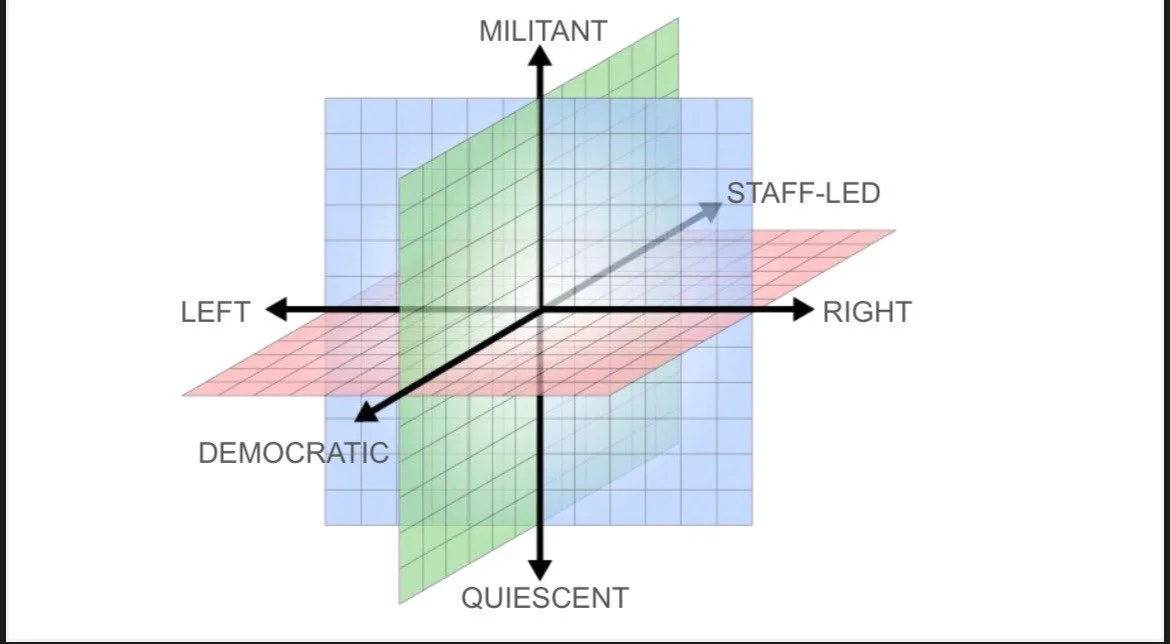Laying the Groundwork for a Class Alignment Labor Strategy, part 1: Theory and Terrain
By Daniel C, Louisville DSA; Lyra S, Chicago DSA; Sumter A, Atlanta DSA
October 18th, 2025
The following is the first part of a four-part series in which the authors propose a new path forward for DSA’s labor strategy. This is not Groundwork’s official stance as of now, but it will be put forward at the caucus convening in early 2026 for a membership vote. In this first part, the authors briefly introduce the strategy they’ve named Class Alignment, then expound on a theoretical framework for understanding labor unions along three axes: militant vs quiescent, democratic vs top-down, and left vs right. The second part will be published tomorrow with the remaining two coming next week. - Ed.
The authors of this piece, as labor organizers, rank-and-file union members, and historians of the labor movement, have noted a need for a new labor strategy, a Class Alignment Strategy. A strategy that explicitly defines DSA’s points of leverage and considers conjunctural factors before utilizing them will aid in rebuilding the labor movement as a whole and will harness DSA’s unique organizational strengths to align the union movement into a left-labor bloc capable of contesting power. This piece serves as an introduction to the Class Alignment strategy, which the authors intend to propose as Groundwork’s official labor strategy at the 2026 caucus convening. We view this as a priority because the presence or absence of militant, democratic, left-wing class struggle unions can fundamentally shift the balance of forces in the ongoing war of position against the capitalist class, not just on the shop floor, but in the electoral arena and in the streets.
While this article will lay out the theoretical basis for the Class Alignment Strategy at length, the authors would like to foreground the immediate tasks it perceives in DSA’s labor work. First, the sorting of membership on a chapter-by-chapter level into Labor Circles based on industry. Second, the creation of nationwide rank-and-file networks for active organizers on an industry-by-industry basis, based on the nationwide Amazon salt network. Third, the creation of DSA-member “sections” for internal organizing on a union-by-union basis. Fourth, greater coordination between chapter-level and national-level labor and electoral bodies, with the goal of harmonizing our labor and electoral work.
These modifications to DSA’s labor institutions are to be made with the short-term goals of internally organizing within our unions to politicize them, to push for investment in new organizing, aligning multiracial public sector unions like SEIU and AFSCME, and creating municipal left-labor blocs based on the model provided by the DSA-LA-UNITE-HERE-UTLA alliance in Los Angeles. However, for any of these changes to move forward, there will need to be significant increases in capacity at the NLC level, which can only be provided by cross-caucus investment in its structures and by hiring new staff.
Theoretical Orientation
This Class Alignment Strategy aims to move beyond pre-2016 DSA’s narrow permeationist strategy, Bread and Roses’s Orthodox Rank and File Strategy, and the everything and the kitchen sink “multifaceted” labor strategy offered by the Collective Power Network. It also attempts to provide an alternative to the Partyist Labor Strategy proposed by Marxist Unity Group, which correctly identifies problems with the rank and file strategy, but falls short of solving them through both a rejection of seizing executive power in the short term and an overemphasis on socialist propagandizing on the shop floor.
The Class Alignment Strategy relies on the process of moving unions (as groups of workers and as institutions) towards opposition to the dominant hegemonic bloc and membership in a left-labor coalition affiliated with DSA. This Left-Labor coalition will be the motive force behind a durable popular-democratic mass movement for a social transformation. Once aligned, a union can be counted on to be on our side of the balance of forces when we confront capital on the shop floors, in the streets, and at the ballot box. What aligning a union might look like depends on a variety of factors, but generally speaking, unions in the United States under the Taft-Hartley labor paradigm can be divided along three main axes:
Axis One: Militant vs Quiescent
A militant union is a union that is willing to walk up the ladder of escalation to majority strikes that will fundamentally transform a member’s life by winning demands that provide security and dignity. Militant unions invest aggressively in new organizing, and the most militant unions are willing to break the Taft-Hartley labor paradigm by engaging in open illegal strikes in defiance of injunctions, risking state repression. A quiescent union is a “dues collection agency” more concerned with maintaining the smooth flow of production than winning for its members. No union is an ideal example of either of these types; however, examples of more militant unions include red-state teachers' unions that engage in wildcat strikes in opposition to state law, many Teamsters locals, and SEIU 1199 NE. Examples of more quiescent unions would be UFCW at Kroger and SEIU’s massive home care locals.
The Rank-and-File Strategy, as it currently exists, has been successful at forming reform caucuses that pull unions towards the militant end of this axis. Shop floor militants from Solidarity, the IS (International Socialists), and later Bread and Roses have played a vital part in the creation of UAW-D and TDU, caucuses explicitly devoted to more militant and democratic unions.
Axis Two: Democratic vs Top-Down
Another important axis within the labor movement is democratic unions vs top-down unions. Democratic unions are characterized by direct election of leadership, openly ideological internal caucuses, large open directly-elected bargaining committees, and open books. Top-down unions are characterized by decision-making power residing with unelected staff and/or entrenched, self-selected leadership, multiple layers of abstraction between the rank-and-file and top leadership, closed-door bargaining, and closed books.
However, neither internal democracy nor militancy is enough to guarantee alignment with a broader socialist political project. The Teamsters have contested direct internal elections, go on strike often, and maintain a militant oppositional orientation towards management, but Sean O'Brien gives millions to Republican candidates, throws immigrants and trans people under the bus, and has aligned against the left-populist anti-oligarchy movement. There is a step beyond militant democratic unions, the project of bringing those unions into a united front to achieve a broad-based anti-imperialist social democratic transformation.
This brings us to the final axis.
Axis Three: Left vs Right
Some unions are left-wing, while others are right-wing. Anyone who has experience with teachers’ unions writ large on one end and the building trades writ large on the other is aware of this. The political orientation of unions rests on the demographics of their membership, the orientation of the institutions that can grant them contracts, and the positions of their leadership.
In this paradigm, at the center is a partisan divide between Red and Blue in the United States, with labor liberalism comprising a broad center-left in the union movement and a tacit pro-Republican workerism making up the center-right. However, our goal is to pull unions far to the left, past labor liberalism, towards alignment with DSA.
Left-wing alignment is harder to measure and to quantify than militancy and internal democracy, as aligned left unions can take a variety of forms and degrees. An ideal left-aligned union would be one with an extensive DSA presence in the rank and file and staff, characterized by close and comradely collaboration between union leadership and local DSA leadership, with a consistent track record of cross-endorsing and throwing its resources behind DSA candidates and issues. These unions are sometimes, but not always, explicitly socialist, and they often include demands in their contracts that relate to broader struggles and achieve wins for the working class as a whole. Additionally, these unions aggressively engage in new organizing that might not immediately result in new members in their core sectors. For example, SEIU 1199NE organizing tenants, or the United Electrical Workers partnering with EWOC and Southern Workers for Justice.
This series continues here with the task facing DSA in the labor movement as well as a discussion of the triumphs and the shortcomings of the DSA’s labor strategy so far.


